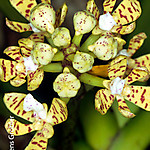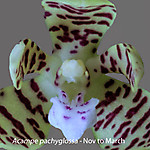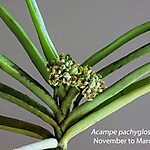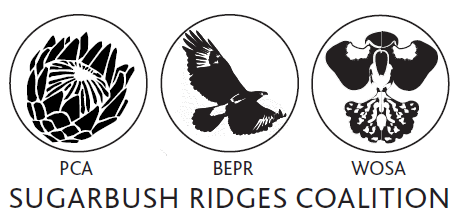Acampe pachyglossa
Description
Acampe pachyglossa is a robust epiphytic plant, sometimes forming small clumps of four to five plants growing together. The stems are stiff and quite woody, while the roots are 6-8 millimetres in diameter. The succulent leaves are placed in two opposite rows along the stem and measure up to 250 millimetres long by 15-25 millimetres wide. The leaves are deeply folded and appear ‘vee-shaped’ in cross-section, with unequally bilobed tips. The flowers are fleshy, with pale yellow sepals and petals that have reddish-purple bands. The lip is white or yellow-white, with a few small purplish spots. Formerly known as Acampe praemorsa.
Distribution in South Africa
Warm, humid, low-elevation forests in northern KwaZulu-Natal, Mpumalanga and Limpopo. Another small population occurs in the cool, moist, high-elevation Debengeni Forest of Magoebaskloof, Limpopo.
Please submit your orchid photographs to OrchidMAP as citizen science records to improve this map.
Register on the Virtual Museum or login.
Typical habitat
Plants grow in shaded positions in open woodland, firmly attached to the trunks and branches of riverine trees.
Flowering Period
Flowering occurs in the summer months of November to March.
Distribution elsewhere in Africa
Acampe pachyglossa is found in Angola, Democratic Republic of Congo (DRC), Kenya, Malawi, Mozambique, Swaziland, Tanzania, Uganda, Zimbabwe, Zambia on the African continent, and the islands of Madagascar, Mauritius, Reunion, the Comoro Islands and Seychelles in the Indian Ocean.
Conservation Status
Click on the distribution map to see the latest conservation status also refer to Provincial Species List on this site for Provincial Red and Orange listing and SANBI Orchid red list.
All orchids are protected under CITES regulations.
References and additional information
Johnson, S.D., Bytebier, B. Stärker, H. (2010). Orchids of South Africa: A field guide. Struik Nature, Cape Town, South Africa.
La Croix, I.F. la Croix, E. (1997). African Orchids in the Wild and in Cultivation. Timber Press, Portland, Oregon, USA.
This genus and species article was written by Peter Ashton and published 2018-10-24
Images




